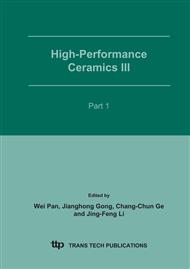p.409
p.413
p.419
p.425
p.431
p.435
p.439
p.443
p.447
Study of YSZ Amperometric Oxygen Sensor with a Dense Barrier Layer
Abstract:
A new type of amperometric oxygen sensor was developed by an approach of co-pressing and co-sintering YSZ solid electrolyte. A dense LSM+YSZ composite electrode which was used as both cathode and diffusion barrier. Pre-sintered composite and YSZ powders were dry-pressed together to form a sheet with dual-layer of LSM+YSZ/YSZ. The sheet was then sintered at 1450°C. The anode was made of Pt paste, which was printed on to the other side of YSZ. The experiment results showed that the oxygen sensor exhibited a quite low operating temperature. At 400°C, the limiting current appeared in the voltage from 0.7 to 1.2V and the limiting current was a good linear relationship with the oxygen concentration up to 10 %. The sensor has some excellent features such as a rapid response, no reference gas, simple configuration and low cost. Taken together with the chemical stability of the diffusion barrier, the sensor is suitable for the control of air-to-fuel ratio in lean-burn internal combustion engines.
Info:
Periodical:
Pages:
431-434
Citation:
Online since:
February 2007
Keywords:
Price:
Сopyright:
© 2005 Trans Tech Publications Ltd. All Rights Reserved
Share:
Citation:


